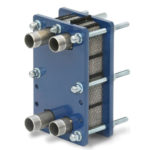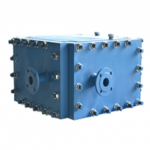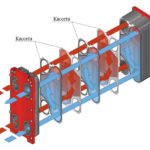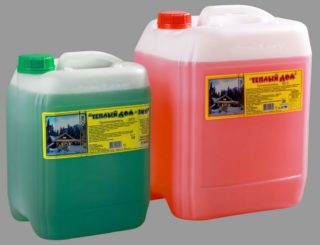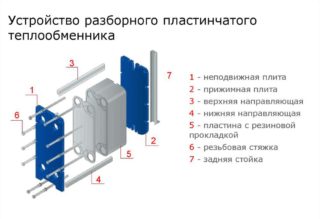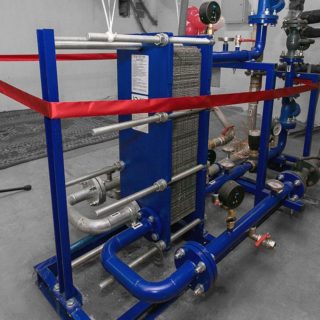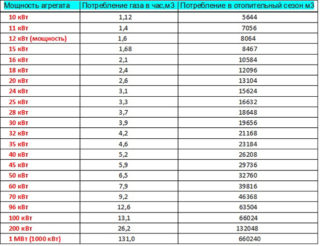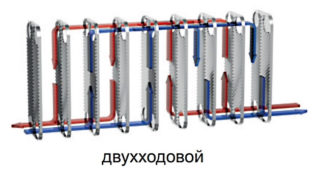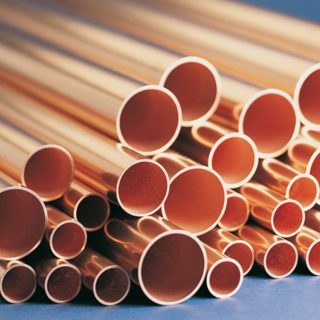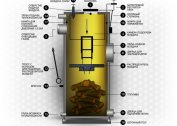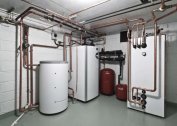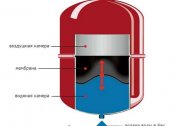A plate heat exchanger is a type of recuperative heat exchanger, the principle of which is based on the conversion and transfer of thermal energy from one medium to another, through contact plates. Collected in a single bundle, they form a kind of channels through which the coolant moves. The parameters and dimensions of the device are indicated by the standards of GOST 15518-83.
Varieties of heat exchangers

Depending on the degree of accessibility to service and inspection, heat exchangers are divided into several types:
- collapsible
- soldered
- welded
- semi-welded.
Collapsible
Devices of this type are assembled and disassembled for periodic maintenance, inspection and repair. The heat transfer process is carried out by means of plates that alternate with each other, forming two contours of motion. This eliminates the mixing of thermal energy between the two streams. All plates are separated by rubber gaskets.
Soldered
Devices of this type are not disassembled, unlike the previously considered type, and all the plates are soldered together. The advantage of such devices is considered affordable cost and small dimensions. The main field of application is domestic gas boilers and other heating systems.
Welded
Units of this class consist of plates welded together without rubber seals. The heat flow moves through two channels: one along the corrugated, the second through the tubular. Among the disadvantages are the high cost of the device and its size. Coolants of this class are used on an industrial scale.
Semi-welded
A design consisting of plates that are installed in a combined manner. Seals are located on the outside of the pairwise welded plates. Such equipment allows its use in extremely aggressive environments or in cooling systems.
- Demountable
- Welded
- Soldered
- Semi-welded
Advantages and disadvantages
Among the positive aspects of the use of such units can be identified:
- lack of large production and investment costs;
- heat supply efficiency;
- small sizes;
- self-cleaning ability due to high turbulent flow;
- by increasing the number of plates, it is possible to achieve an increase in efficiency;
- reliability;
- ease of maintenance and flushing;
- light weight;
- ease of installation;
- minimal surface contamination;
- the complete exclusion of mixing different types of coolant, thanks to a special sealing system;
- resistance to corrosion;
- high efficiency ensures a minimum heat exchange surface;
- the possibility of reducing pressure losses to minimum by using plates with different types of profiles;
- temperature adjustment.
The disadvantages of plate heat exchangers include:
- the need for grounding;
- exactingness to the quality of the coolant.
A large number of advantages allows the use of heat exchangers in the domestic and industrial segment. Demanding for the coolant is more likely not a disadvantage, but a need to prevent the frequency of replacement of worn out plates.
The device plate heat exchangers
The plate heat exchanger is widely used for heat exchange in vapors or liquids and acts as a cooler, heater or condenser. It consists of several components:
- movable plate;
- fixed plate;
- nozzles, with threaded flange and welded connection;
- a set of plates fastened together;
- lower and upper guide;
- threaded stand for mounting and studs.
Between the plates are rubber seals. The movement of thermal energy occurs in several ways:
- direct flow,
- countercurrent
- mixed.
The selection of equipment for installation in the heating system and the calculation are performed using special software developed specifically for these purposes.
Wiring diagram
To connect plate TO, a classic circuit is used in which the coolant inlet and outlet pipes are located on the front panel. Most often, these openings are positioned in such a way as to provide a counterflow of thermal energy and to prevent mixing of hot and cold flow.
The second option for connecting the heat exchanger uses the same inlet and outlet nozzles, which can be located not only on the front panel, but also on the rear.
The input and output flows of thermal energy are connected by means of pipes with a flanged, threaded or welded connection.
In some cases, do not use nozzles. Then the connection occurs by drilling additional holes with internal thread for the installation of studs, which will serve as a fastener for the coolant with the pipeline. As a gasket, you can take a heat-resistant rubber or rubber seal.
Selection rules
The choice of equipment depends on several parameters, each of which is calculated individually, depending on where the heat exchanger will be installed.
When selecting a model, you need to determine the following points:
- type of medium (steam, water, etc.);
- temperature indicators at the inlet and outlet of the coolant;
- permissible pressure loss;
- maximum temperature
- maximum pressure inside the device;
- thermal load on the equipment.
After obtaining data on these parameters, it is necessary to calculate the indicators of the heat exchange system. Then you can start choosing a model, based on the available indicators of power, water flow rate, diameter and heat transfer area.
Principle of operation
The principle of operation of the plate heat exchanger cannot be called simple. The plates are mounted at an angle of 180 degrees relative to each other. Usually this is a spike of two pairs of plates that provide input and output of thermal energy. The extreme pair is not involved in the heat transfer process.
Depending on the design features, heat exchangers are usually divided into three types:
- single-circuit,
- multi-circuit
- two-way.
The circulation of thermal energy in a single-circuit device is performed permanently, along the entire circuit and in one direction, with a simultaneous counterflow of the coolant.
The movement of the thermal carrier in multi-circuit equipment occurs in various directions. Such devices are used only if there is a slight difference in temperature in the return and inlet flow.
The movement of thermal energy in two-way devices occurs along two independent circuits, subject to constant monitoring of the heat supply.
There is another type of device - a steam plate heat exchanger, which is responsible for heating water or other liquid in the heating system. The principle of operation of this device is no different from standard models of plate aggregates.
Plate Heat Exchanger Plates
The material for the plates is steel, 1 mm thick. In order to turbulize the coolant flow and increase the heat transfer area, the flow part of the plates is formed ribbed or in the form of corrugations.
If you look in cross section, the corrugated surface has the profile of an equilateral triangle. The resistance and flow rate depend on the degree of the angle at which the corrugation is located. The sharper it is, the lower the resistance and the higher the coolant speed.
In addition to steel, other alloys are also used to make the heat exchanger plates, depending on where the device will work.
Fields of application
Each type of heat exchanger has its own field of application.
Collapsible heat exchangers are commonly used:
- for installation of heating networks;
- in refrigerators;
- in pools, etc.
Soldered devices are used:
- in freezers;
- in air conditioning systems;
- in ventilation systems;
- in compressor installations.
Welded and semi-welded devices have found their application:
- in climate control and ventilation systems;
- in the pharmaceutical industry;
- in the food industry;
- in heating systems and hot water supply;
- in circulation pumps, etc.
In household use, the most often soldered type of heat exchanger. He is responsible for cooling or heating thermal energy.
A heat exchanger is an element of the system used in the public utilities, food, metallurgy and oil and gas industries, as well as in shipbuilding. The predominance of advantages over disadvantages indicates its effective application. Having correctly decided on the technical characteristics and tasks of the device, you can install the heating system at home using the drawings and wiring diagrams of the heat exchanger, available on the Internet.
